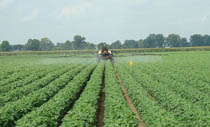- High Technology Service
for Preventing Attacks
of Fungal Diseases in Viticulture
Description
The DecaVelta System
It consists in the creation and in time management of an integrated control system of agricultural and industrial activities, relative to the production of wine. This through the monitoring of climatic, pathological, nutritional, and fermentative variables, among others, that affect or could influence the qualitative productive process.
Not only Viticotura

In 2006 DECA SPA created DecaVelta: a revolutionary system that uses Artificial Intelligence for the prediction of diseases in vineyards. Through the use of meteorological sensors and acquisition of data it is able to reduce the use of pesticides and treatments on plants and to prevent diseases by predicting them on time, so as to improve the final quality of the product.
It is important to understand that this system is applicable to all sectors of agriculture and not just that of vineyards, so as to have a complete control of whatever crop one is trying to grow, and to be able to harvest in a more efficient and less costly way, while respecting the environment. Another fundamental aspect of Agriveltha is its tracking ability, through the use of Artificial Neural Networks (ANN) it is able to foresee diseases and detect faults, this obviously resulting in great savings.
The aim of DecaVelta

The primary aim of the project is that of foreseeing the onset of diseases such as downy mildew and powdery mildew, and of limiting the use of pesticides in the cultivation of vineyards, allowing the firms in this sector:
*to obtain a product that is qualitatively better and quantitatively unaltered,
* to keep those variables that influence the quality and quantity of production under control,
* o optimize plant protection measures by evaluating conditions favorable to the devolpement of pathogens on the basis of which one can decide when to intervene,
* to avoid traditional fixed treatments reducing the number of interventions to a minimum,
* to increase the knowledge in the area of development of diseases related to various types of variables,
* to reduce costs,
* to minimize soil contamination.
more info